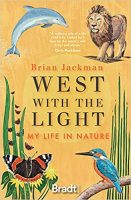 I was in touch recently with the writer Brian Jackman, who, I discovered about 10 years ago, was a boy during the Second World War just down the road from where I’m living now, before being evacuated to a farm in Cornwall during the Blitz. He has long been writing for the Telegraph travel pages as a freelance (and before that was a Fleet Street messenger boy and then on the staff of The Sunday Times). Many years before he set eyes on the Maasai Mara, which he has described vividly in his books with the film-maker Jonathan Scott, The Big Cat Diary and The Marsh Lions, Brian had imagined it in the London suburb of Stoneleigh. In Nonsuch Park — named for a peerless but long-gone Tudor palace — he and his mates turned hawthorn hedges into African savannah, “made Robin Hood bows from young ash staves and built Apache dens among the cow parsley”. He remembers, too, seeing a Hurricane shoot down a Messerschmitt over his own street.
I was in touch recently with the writer Brian Jackman, who, I discovered about 10 years ago, was a boy during the Second World War just down the road from where I’m living now, before being evacuated to a farm in Cornwall during the Blitz. He has long been writing for the Telegraph travel pages as a freelance (and before that was a Fleet Street messenger boy and then on the staff of The Sunday Times). Many years before he set eyes on the Maasai Mara, which he has described vividly in his books with the film-maker Jonathan Scott, The Big Cat Diary and The Marsh Lions, Brian had imagined it in the London suburb of Stoneleigh. In Nonsuch Park — named for a peerless but long-gone Tudor palace — he and his mates turned hawthorn hedges into African savannah, “made Robin Hood bows from young ash staves and built Apache dens among the cow parsley”. He remembers, too, seeing a Hurricane shoot down a Messerschmitt over his own street.
About a month ago I was scribbling about Nonsuch, and sent the copy to Brian to check something. I got an email back saying that he had just received proofs of his new memoir — West with the Light: My Life in Nature — in which Stoneleigh and Nonsuch figure large in the early pages. Later on, he’s in the real savannah: over the past 40 years or so, in his wanderings across sub-Saharan Africa, he reckons he has spent the best part of four years under canvas. As well as observing the beasts of the bush, he’s met characters including George and Joy Adamson and Richard Leakey.
The book is due to be published by Bradt in August. It’s not one I’ll be able to review as I know Brian too well, but I wanted to mention it here.
I first registered the byline “Brian Jackman” in the early 1980s, in typescript on the sub-editors’ desk of The Sunday Times, on the fifth floor of 200 Gray’s Inn Road, where I worked initially as a casual. On Saturday my colleagues and I subbed stories appearing in the early pages of the paper, which tended to be “hard” news in several senses of the word (though not necessarily as hard as in the front page from an old New York Post stuck to a partition that screened off the picture desk: “HEADLESS BODY IN TOPLESS BAR”). On Fridays we worked mainly on foreign-desk stories and on softer pieces from other parts of the paper. Occasionally there would be something from Brian, either for the travel section, which sent him everywhere from the Falkland Islands to Everest Base Camp, or for the later pages of the news section, where he was among writers given space for the way they told a story as much as for the story itself. Dropping the copy on my desk, the then chief sub, John Wardroper, a lean and learned Canadian, would say: “Here’s a little treat for you: another lovely piece from Brian Jackman. Just tick it up.” In other words, breathe on it, but don’t edit it.
You can read more of Brian Jackman’s work, extracted from earlier books on Africa and Britain, here on Deskbound Traveller.

Leave a Reply